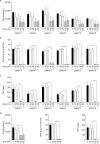Extracellular vesicles are associated with C-reactive protein in sepsis
- PMID: 33772103
- PMCID: PMC7997920
- DOI: 10.1038/s41598-021-86489-4
Extracellular vesicles are associated with C-reactive protein in sepsis
Abstract
There is increasing evidence that C-reactive protein (CRP) can mediate inflammatory reactions following the transformation of functionally inert pentameric CRP (pCRP) into its structural isoform pCRP* and into monomeric CRP (mCRP). This conversion can occur on the membranes of apoptotic or activated cells or on extracellular vesicles (EVs) shed from the cell surface. Here, we characterized the association of CRP with EVs in plasma from sepsis patients using flow cytometry, and found highly elevated levels of total EV counts and CRP+ EVs as compared to healthy individuals. We further assessed the ability of PentraSorb CRP, an extracorporeal device for the adsorption of CRP, to deplete free CRP and CRP+ EVs. Treatment of septic plasma with the adsorbent in vitro resulted in almost complete removal of both, free CRP and CRP+ EVs, while total EV counts remained largely unaffected, indicating the detachment of CRP from the EV surface. EVs from septic plasma elicited a release of interleukin-8 from cultured human monocytes, which was significantly reduced by adsorbent treatment prior to EV isolation. Our findings provide evidence that CRP+ EVs exhibit pro-inflammatory characteristics and can contribute to the spreading of inflammation throughout the circulation on top of their pro-coagulant activity.
Conflict of interest statement
The authors declare no competing interests.
Figures



Similar articles
-
Extracellular vesicles opsonized by monomeric C-reactive protein (CRP) are accessible as autoantigens in patients with systemic lupus erythematosus and associate with autoantibodies against CRP.J Autoimmun. 2023 Sep;139:103073. doi: 10.1016/j.jaut.2023.103073. Epub 2023 Jun 23. J Autoimmun. 2023. PMID: 37356347
-
Dissociation of C-Reactive Protein Localizes and Amplifies Inflammation: Evidence for a Direct Biological Role of C-Reactive Protein and Its Conformational Changes.Front Immunol. 2018 Jun 12;9:1351. doi: 10.3389/fimmu.2018.01351. eCollection 2018. Front Immunol. 2018. PMID: 29946323 Free PMC article. Review.
-
Dissociation of pentameric to monomeric C-reactive protein on activated platelets localizes inflammation to atherosclerotic plaques.Circ Res. 2009 Jul 17;105(2):128-37. doi: 10.1161/CIRCRESAHA.108.190611. Epub 2009 Jun 11. Circ Res. 2009. PMID: 19520972
-
The binding of monomeric C-reactive protein (mCRP) to Integrins αvβ3 and α4β1 is related to its pro-inflammatory action.PLoS One. 2014 Apr 2;9(4):e93738. doi: 10.1371/journal.pone.0093738. eCollection 2014. PLoS One. 2014. PMID: 24695572 Free PMC article.
-
C-reactive protein: how conformational changes influence inflammatory properties.Cell Cycle. 2009 Dec;8(23):3885-92. doi: 10.4161/cc.8.23.10068. Epub 2009 Dec 14. Cell Cycle. 2009. PMID: 19887916 Review.
Cited by
-
Pattern Recognition Proteins: First Line of Defense Against Coronaviruses.Front Immunol. 2021 Sep 23;12:652252. doi: 10.3389/fimmu.2021.652252. eCollection 2021. Front Immunol. 2021. PMID: 34630377 Free PMC article. Review.
-
Infection with SARS-CoV-2 Is Associated with Elevated Levels of IP-10, MCP-1, and IL-13 in Sepsis Patients.Diagnostics (Basel). 2023 Mar 11;13(6):1069. doi: 10.3390/diagnostics13061069. Diagnostics (Basel). 2023. PMID: 36980378 Free PMC article.
-
Expression of Tissue Factor and Platelet/Leukocyte Markers on Extracellular Vesicles Reflect Platelet-Leukocyte Interaction in Severe COVID-19.Int J Mol Sci. 2023 Nov 28;24(23):16886. doi: 10.3390/ijms242316886. Int J Mol Sci. 2023. PMID: 38069209 Free PMC article.
-
Monomeric C-Reactive Protein: Current Perspectives for Utilization and Inclusion as a Prognostic Indicator and Therapeutic Target.Front Immunol. 2022 Mar 4;13:866379. doi: 10.3389/fimmu.2022.866379. eCollection 2022. Front Immunol. 2022. PMID: 35309334 Free PMC article. Review.
-
The roles of extracellular vesicles in the immune system.Nat Rev Immunol. 2023 Apr;23(4):236-250. doi: 10.1038/s41577-022-00763-8. Epub 2022 Aug 4. Nat Rev Immunol. 2023. PMID: 35927511 Free PMC article. Review.
References
Publication types
MeSH terms
Substances
LinkOut - more resources
Full Text Sources
Other Literature Sources
Medical
Research Materials
Miscellaneous

